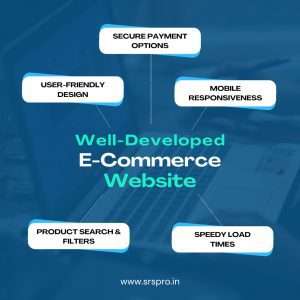Building an e-commerce website might feel daunting, but it’s simpler than you think. With a solid plan, the right tools, and professional help, you can create an online store that is both attractive and effective.
In this guide, we will simplify everything you need to learn about e-commerce website development into easy steps. Let’s get started!
What is E-commerce Website Development?
E-commerce website development is the process of creating a digital platform where you can sell your products online. Consider it as your virtual storefront. It includes designing the website layout, adding product pages, setting up payment gateways, and ensuring a seamless shopping experience for customers.
Having an e-commerce site is essential in today’s digital-first world to get customers through effective digital marketing strategies.
Why Does Your Business Need an E-commerce Website?
Here’s the deal: online shopping isn’t a luxury anymore – it’s a necessity. Businesses that don’t sell online risk missing out on millions of potential customers. Here’s why you need one:
- 24/7 Accessibility: Your store is always open, even when you’re asleep.
- Wider Reach: Sell to customers worldwide without opening multiple physical stores.
- Cost-Effective: Save on rent, staff, and other operational expenses.
- Improved Customer Insights: Track user behavior to improve products and marketing strategies.
What are the Key Features of a Successful E-commerce Website Development?

Developing a great e-commerce website isn’t just about good looks. It’s about function, speed, and user experience. Here are the must-have features:
1. User-Friendly Design
Ensure that visitors can easily locate what they’re looking for. A clean layout, clear navigation, and responsive design are non-negotiable.
2. Secure Payment Options
Customers need to trust your website. Add multiple payment options like UPI, debit and credit cards, digital wallets, and cash on delivery. Don’t forget SSL certification for encrypted transactions.
3. Mobile Responsiveness
Did you know most online purchases happen on mobile phones? If your site isn’t mobile-friendly, you’re losing customers.
4. Product Search and Filters
Make shopping easier. Allow users to search for products, apply filters, and sort by price, rating, or popularity.
5. Speedy Load Times
Nobody has time for slow websites. Optimize images, reduce code bloat, and use a reliable hosting service.
What are the Steps for E-commerce Website Development?
Building an e-commerce website involves several steps. Here’s a simplified breakdown:
Step 1: Pick a Domain Name
Your domain name is your online address. Choose something catchy, easy to spell, and relevant to your brand.
Step 2: Choose the Right Platform
Popular platforms like WordPress and WooCommerce offer everything you need to get started. Choose one based on your budget and requirements.
Step 3: Design Your Website
Customize your layout, fonts, and colors. Don’t overcrowd your pages. Focus on creating a clean, simplified user interface.
Step 4: Add Products
Upload images and detailed descriptions for each product. Include dimensions, materials, and usage instructions to help customers decide.
Step 5: Integrate Payment Gateways
Add payment options that suit your target audience. Popular ones include UPI, debit and credit cards, digital wallets, cash on delivery, PayPal, and Razorpay.
Step 6: Test
Before going live, test every feature. Check for broken links, ensure the checkout process works, and verify mobile responsiveness.
What Common Mistakes Do You Need to Avoid in E-commerce Website Development?
Here’s what NOT to do when developing your e-commerce website:
- Ignoring SEO: If people can’t find you on Google, you’ll struggle to make sales. Focus on the best SEO strategies when developing a site like keyword optimization, fast loading speeds, and mobile-friendliness.
- Complicated Checkout Process: A lengthy checkout process frustrates customers. Make it short and sweet.
- Poor Product Descriptions: Lazy descriptions turn away buyers. Write detailed and engaging content.
- Lack of Customer Support: To enhance customer satisfaction, it is crucial to implement robust customer support channels. Add live chat or a contact form to address queries quickly.
What is the Role of SEO in E-commerce Website Development?
Search Engine Optimization (SEO) is crucial. It helps your website rank higher on search engines, attracting organic traffic. Here’s how to make your e-commerce site SEO-friendly:
- Keyword Research: Find the terms your audience uses to search for products. Use them naturally in your titles, descriptions, and URLs.
- Fast Load Speeds: Google loves fast websites. Reduce image sizes and use a content delivery network (CDN).
- Meta Tags: Write unique meta titles and descriptions for each page.
- Backlinks: Build authority by getting links from trusted websites in your industry.
How to Maintain Your E-commerce Website?
Your work doesn’t end once you have completed the e-commerce website development and your website is live. Regular maintenance ensures smooth operation. Here’s what you need to do:
- Update product listings and remove out-of-stock items.
- Keep your website secure with regular software updates.
- Monitor performance metrics like bounce rates and cart abandonment.
- Run promotions and seasonal sales to keep customers coming back.
Future Trends in E-commerce
The e-commerce landscape is constantly evolving. Here’s what’s trending:
- AI-Powered Recommendations: Tools like personalized shopping suggestions can boost sales.
- Voice Search Optimization: More people are shopping using voice commands. Optimize your site for voice search.
- Sustainable Practices: Eco-friendly products and packaging are gaining popularity.
- Augmented Reality (AR): Allow customers to try products virtually, like furniture or clothing.
Why Choose SRS Pro for Your E-commerce Website Development?
If you’re ready to build your dream e-commerce website, SRS Pro is your go-to partner. Known as the best website development company in Ahmedabad, Gujarat, India, SRS Pro offers cutting-edge web solutions tailored to your business needs. With our expert team at your service, you’ll get a sleek, fast, and SEO-friendly website that drives sales and boosts your brand.
Get in touch with us today and watch your e-commerce vision come to life!
Conclusion
A good e-commerce website development is the foundation of a successful online business. By focusing on user experience, SEO, and future trends, you can create a platform that not only attracts customers but keeps them coming back.
Partner with SRS Pro – the best web design and development agency to turn your e-commerce goals into reality and stay ahead in the online marketplace.



